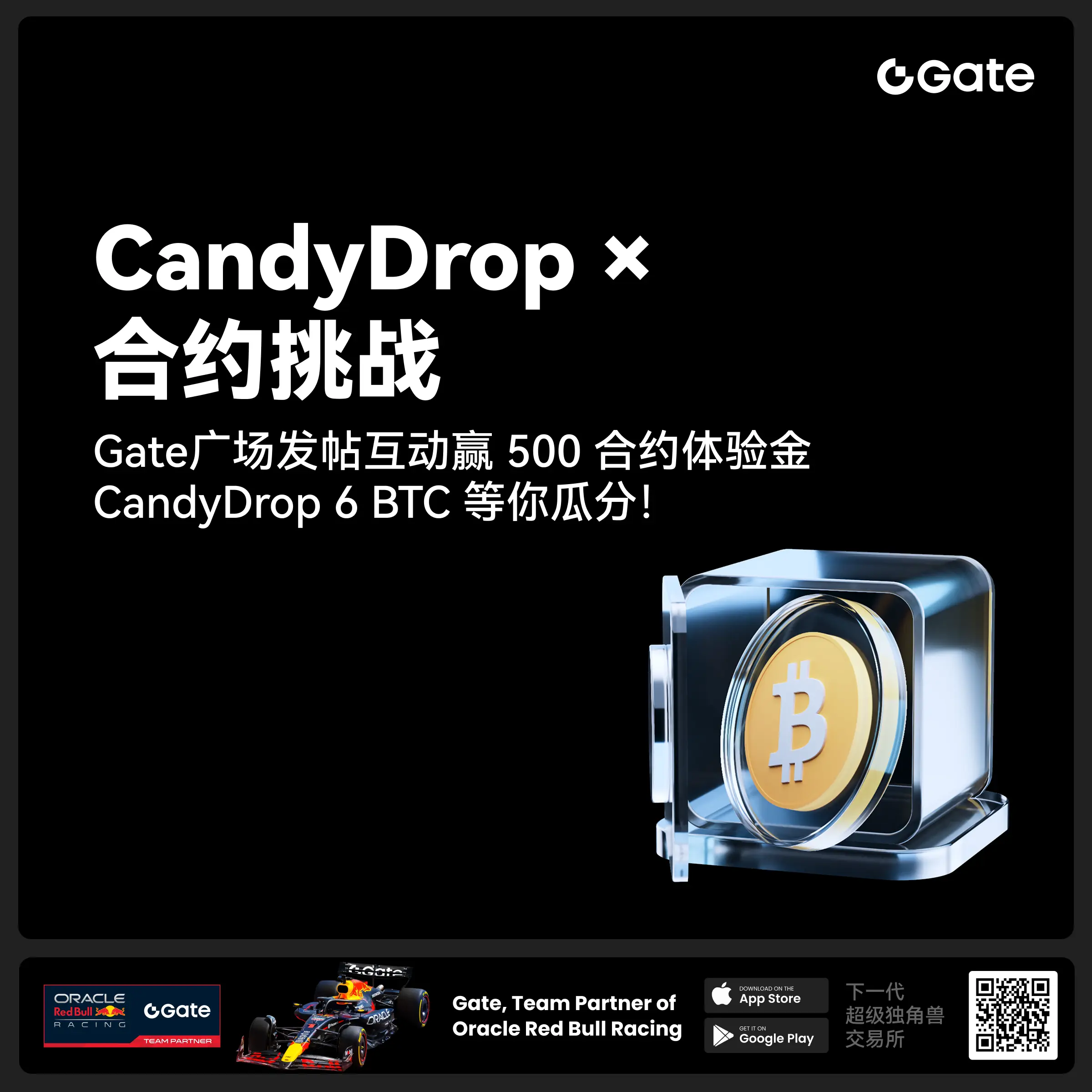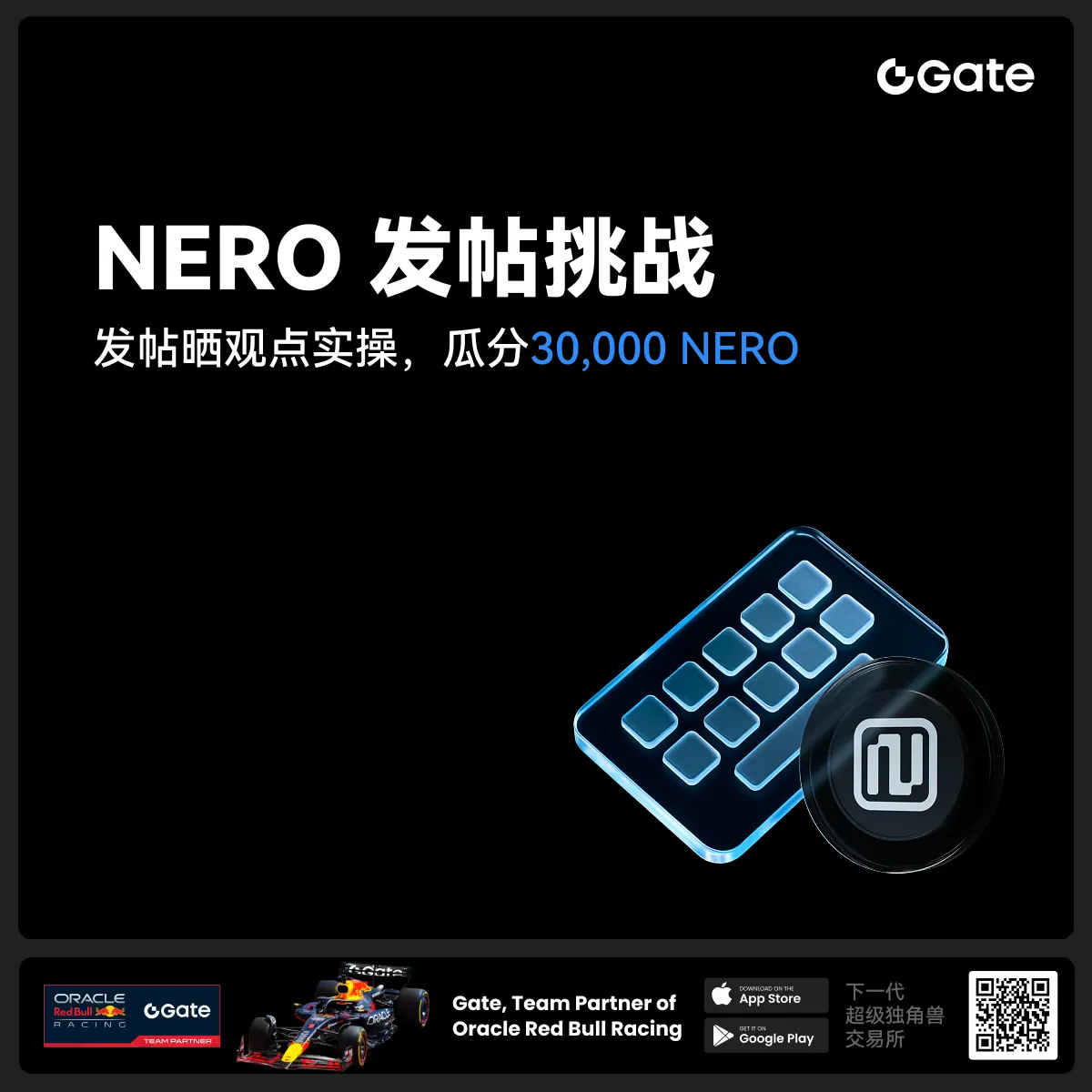- 话题1/3
33k 热度
22k 热度
40k 热度
8k 热度
21k 热度
- 置顶
- 🎉 #CandyDrop合约挑战# 正式开启!参与即可瓜分 6 BTC 豪华奖池!
📢 在 Gate 广场带话题发布你的合约体验
🎁 优质贴文用户瓜分$500 合约体验金券,20位名额等你上榜!
📅 活动时间:2025 年 8 月 1 日 15:00 - 8 月 15 日 19:00 (UTC+8)
👉 活动链接:https://www.gate.com/candy-drop/detail/BTC-98
敢合约,敢盈利
- 🎉 攒成长值,抽华为Mate三折叠!广场第 1️⃣ 2️⃣ 期夏季成长值抽奖大狂欢开启!
总奖池超 $10,000+,华为Mate三折叠手机、F1红牛赛车模型、Gate限量周边、热门代币等你来抽!
立即抽奖 👉 https://www.gate.com/activities/pointprize?now_period=12
如何快速赚成长值?
1️⃣ 进入【广场】,点击头像旁标识进入【社区中心】
2️⃣ 完成发帖、评论、点赞、发言等日常任务,成长值拿不停
100%有奖,抽到赚到,大奖等你抱走,赶紧试试手气!
截止于 8月9日 24:00 (UTC+8)
详情: https://www.gate.com/announcements/article/46384
#成长值抽奖12期开启#
- 📢 Gate广场 #NERO发帖挑战# 秀观点赢大奖活动火热开启!
Gate NERO生态周来袭!发帖秀出NERO项目洞察和活动实用攻略,瓜分30,000NERO!
💰️ 15位优质发帖用户 * 2,000枚NERO每人
如何参与:
1️⃣ 调研NERO项目
对NERO的基本面、社区治理、发展目标、代币经济模型等方面进行研究,分享你对项目的深度研究。
2️⃣ 参与并分享真实体验
参与NERO生态周相关活动,并晒出你的参与截图、收益图或实用教程。可以是收益展示、简明易懂的新手攻略、小窍门,也可以是行情点位分析,内容详实优先。
3️⃣ 鼓励带新互动
如果你的帖子吸引到他人参与活动,或者有好友评论“已参与/已交易”,将大幅提升你的获奖概率!
NERO热门活动(帖文需附以下活动链接):
NERO Chain (NERO) 生态周:Gate 已上线 NERO 现货交易,为回馈平台用户,HODLer Airdrop、Launchpool、CandyDrop、余币宝已上线 NERO,邀您体验。参与攻略见公告:https://www.gate.com/announcements/article/46284
高质量帖子Tips:
教程越详细、图片越直观、互动量越高,获奖几率越大!
市场见解独到、真实参与经历、有带新互动者,评选将优先考虑。
帖子需原创,字数不少于250字,且需获得至少3条有效互动
- 🎉 亲爱的广场小伙伴们,福利不停,精彩不断!目前广场上这些热门发帖赢奖活动火热进行中,发帖越多,奖励越多,快来GET你的专属好礼吧!🚀
1️⃣ #GateLaunchpad上线IKA# |IKA认购体验
在Gate广场带话题晒出你的IKA Launchpad认购体验,4位幸运分享者讲瓜分$200分享奖池!
详情 👉️ https://www.gate.com/post/status/12566958
2️⃣ #ETH冲击4800# |行情分析预测
大胆发帖预测ETH走势,展示你的市场洞察力!10位幸运用户将平分0.1 ETH 奖励!
详情 👉️ https://www.gate.com/post/status/12322403
3️⃣ #创作者活动第二期# |ZKWASM话题
在广场或推特发布与 ZKWASM 或其交易活动相关的原创内容,瓜分4,000枚ZKWASM!
详情 👉️ https://www.gate.com/post/status/12525794
4️⃣ #Gate广场征文活动第二期# |ERA话题
谈谈你对ERA的观点/体验,参与并推广活动,700 ERA大奖等你赢!
详情 👉️ https://www.gate.com/post/status/12361653
5️⃣ #MBG任务挑战# |MBG话题
分享你对MBG的洞察,积极参与和推广MBG活动,20位小 - 🎉Gate 2025 上半年社区盛典:内容达人评选投票火热进行中 🎉
🏆 谁将成为前十位 #Gate广场# 内容达人?
投票现已开启,选出你的心头好
🎁赢取 iPhone 16 Pro Max、限量周边等好礼!
📅投票截止:8 月 15 日 10:00(UTC+8)
立即投票: https://www.gate.com/activities/community-vote
活动详情: https://www.gate.com/announcements/article/45974
Telegram is not a neobank — it’s the platform where the next ones are born
Opinion by: Vlad Kamyshov, CEO of Evaa Protocol
The race to build the next big Web3 neobank is missing the point. Most projects are still focused on launching standalone apps, creating new interfaces and rebuilding user acquisition strategies from the ground up. It’s a familiar playbook, and increasingly an outdated one. In crypto, the next generation of finance won’t ask users to switch apps; it’ll meet them where they already are.
Telegram and The Open Network (TON) aren’t trying to become neobanks themselves. They’ve already moved beyond that contest — one where Revolut and Monzo still fight for share. Together, they offer what nearly every crypto banking product lacks: a built-in audience, an intuitive interface, distribution embedded inside existing user flows and the rails to deliver instant financial utility
While others compete on features and flash, TON quietly provides the infrastructure to scale Web3 finance invisibly.
The future isn’t app-based — it’s embedded
Ethena’s integration into TON signals a deeper shift in the Web3 banking playbook. It shows that success won’t come from creating shinier decentralized finance (DeFi) frontends. It will come from embedding powerful tools into the platforms that users already know and trust
With over 100 million TON wallets and 1 billion-plus Telegram users, TON has already solved crypto’s most complex challenge: distribution.
Related: Pudgy Penguins debuts play-to-win game on TON
The Web3 sector often confuses innovation with reinvention. But users don’t need another app — they need less friction. Telegram flips the script. Instead of asking people to change their behavior, they make crypto flow directly into existing habits. UX, not APY, is now the competitive frontier.
Most people won’t wade through automated market-maker liquidity pools or staking dashboards to earn passive yield. The breakout moment for Web3 finance won’t be technical — it’ll be behavioral
Tap-to-yield, embedded directly into Telegram, sets a new benchmark for usability. Users can deposit USDe and start earning with just a few taps. No external wallets. No new accounts. No friction.
If crypto ever hopes to scale, it must stop selling complexity and deliver invisible infrastructure that works. Web3 doesn’t need to explain itself to everyone. It needs to become intuitive enough that no explanation is required.
TON is assembling the rails for an invisible financial layer
Ethena is only one part of a growing ecosystem. TON is stitching together the components of a financial super-app — not through marketing campaigns, but through utility. Tether Gold now offers onchain access to tokenized gold stored in Swiss vaults, and soon, through tgBTC, users can hold and spend Bitcoin natively within Telegram without ever touching a traditional wallet or exchange
This isn’t a collection of tools. It’s the blueprint for a new kind of financial access layer — one that dissolves into the background while reshaping how users interact with digital assets.
Onchain is no longer the main battleground
While other layer 1s compete on throughput, fees and total value locked, Telegram has already claimed the most important territory: the interface. Telegram Mini Apps, bots and built-in wallets allow financial services to be experienced as part of chat — not something users must consciously “log in to.”
This is what mainstream adoption actually looks like. Not dashboards made for traders but smooth flows, minimal friction and finance that feels like messaging. Telegram has already onboarded the next billion users. TON is building the rails that will activate them.
The crypto industry is clinging to a myth: that the best product wins. In reality, the best interface already won
DeFi’s next chapter is about attention, not APYs
Yield-maximizing strategies and technical complexity defined the early DeFi playbook. But most users don’t want to optimize. Instead, they want to participate. Telegram’s ecosystem offers that participation without the steep learning curve. Financial services arrive natively inside the space where users already spend their time.
To be clear, there’s still room for standalone innovation. Projects betting on user migration rather than user momentum may be disadvantaged in the era of embedded Web3 finance.
The projects that continue to chase growth through standalone apps and UX-heavy flows may soon find themselves out of step. Attention is the new on-ramp. The real question isn’t how users will discover new apps — it’s whether financial services can reach them before they have to look.
The road ahead: From apps to access
Tightly integrated with Telegram, the next phase of TON’s evolution is set to redefine how users engage with finance. AI agents are expected to become personal assistants who guide users, execute transactions and simplify the complexities of crypto. Bitcoin (BTC) in Telegram won’t just be a store of value — it will power lending, payments and more. And new DeFi savings products will merge blockchain utility with the intuitive, mobile-native simplicity people expect from modern neobanks.
The race to build the next Web3 neobank may already be over — not because one app won, but because one platform rewrote the rules. The winners will be the ones who embed, not compete
The rest may find they built the right product… in the wrong place.
Opinion by: Vlad Kamyshov, CEO of Evaa Protocol.
This article is for general information purposes and is not intended to be and should not be taken as legal or investment advice. The views, thoughts, and opinions expressed here are the author’s alone and do not necessarily reflect or represent the views and opinions of Cointelegraph.